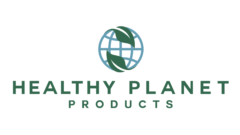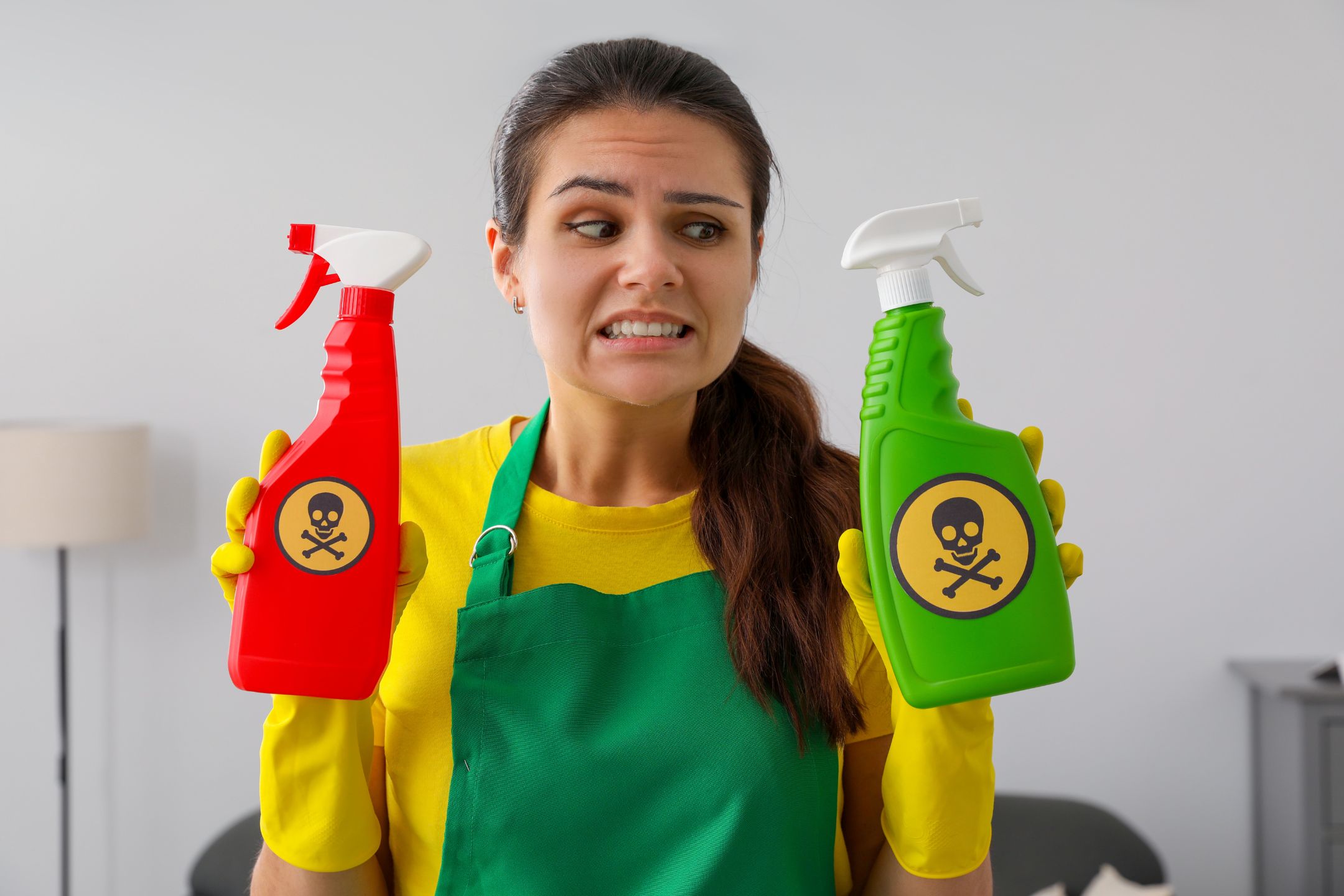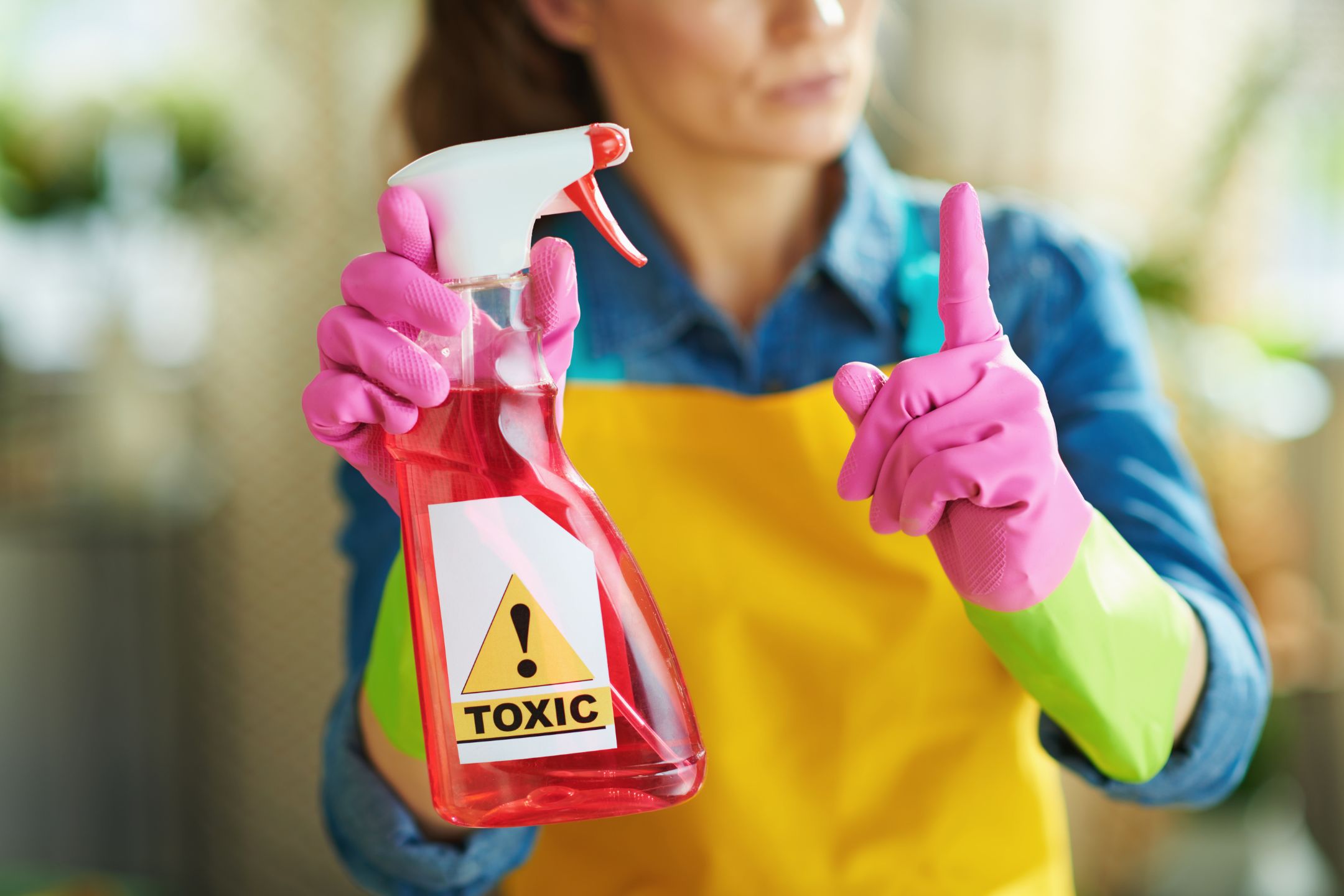Are you ready to ditch the harmful ingredients in household cleaners? Discover the top toxic cleaning ingredients to avoid and switch to healthier alternatives with Healthy Planet Products!
Hey, ever worry about bad ingredients in household cleaners when you’re spraying your kitchen countertops with regular cleaners? Yeah, there are a ton of harmful ingredients in household cleaning products that can harm your health and the environment. 😱
They can cause all sorts of problems, from allergies and skin irritations to more serious issues like respiratory problems, messed up hormones, and even an increased risk of cancer.
And here’s the real kicker: when you wash them down the drain, they end up polluting our waterways and causing harm to wildlife and the whole ecosystem!
But hey, here at Healthy Planet Products, we believe in the power of nature to clean things up without putting your health or our planet at risk! Our cleaning products are made with natural, biodegradable ingredients, so you can keep your home spick and span and your family totally safe.
You’re welcome. ☺️
But, just in case you are still wondering about the toxic ingredients in cleaning products, let’s talk about the top toxic/harmful ingredients to avoid in household cleaners! You’ll want to get rid of these top culprits pronto!
9 harmful ingredients in household cleaning products to watch out for

What toxic ingredients in conventional cleaning products should you avoid at all cost? This list will shock you for sure!
1. Ammonia
First up – ammonia, that colorless gas with its unmistakable pungent smell that we often find in household cleaning products. (Personally, it makes me think of urine! 😆)
But it’s a powerful ingredient used in window cleaners, drain cleaners, toilet bowl cleaners, and even some multi-purpose cleaners. But here’s the thing – as useful as it may be, ammonia based cleaners actually pose some health risks that we should be aware of.
According to the New York Department of Health, breathing in high concentrations of ammonia can cause immediate burning sensations in our nose, throat, and respiratory tract. In more serious cases, it can even lead to respiratory distress or failure.
Scary stuff, right? But it doesn’t stop there.
A study published in the Journal of Occupational and Environmental Medicine found that long-term exposure to low concentrations of ammonia through inhalation can contribute to chronic respiratory illnesses. Yikes!
And here’s a real concern – when ammonia mixes with bleach, which is quite common during our cleaning routines, it creates a poisonous chlorine gas called chloramine. Inhaling this gas can cause teary eyes, a runny nose, a sore throat, coughing, and chest congestion.
Definitely not something we want to mess with.
2. Chlorine Bleach (Sodium Hypochlorite)
Next up – chlorine bleach, or as scientists call it, Sodium Hypochlorite. You can find this stuff in lots of household cleaning products like laundry detergents, kitchen cleaners, and toilet bowl cleaners. It’s pretty famous for being a powerful disinfectant, which is why people use it to keep things nice and clean.
But, we can’t ignore the fact that chlorine bleach can be harmful. The CDC says that if you’re exposed to undiluted bleach or breathe in those bleach fumes, it can irritate your eyes, burn your skin, and mess with your respiratory system.
I mean, if you’ve ever cleaned with the stuff, you can probably attest to that!
What’s worse is that you might get chest pains or even start throwing up. 😬
And get this – Science Daily shared a study in the BMJ that found kids were more likely to get respiratory infections and other infections when they were exposed to bleach at home. That’s pretty scary, right?
It almost makes you want to NOT clean! 😂🤣
Whenever possible, it’s a good idea to look for safer options.
3. Phthalates
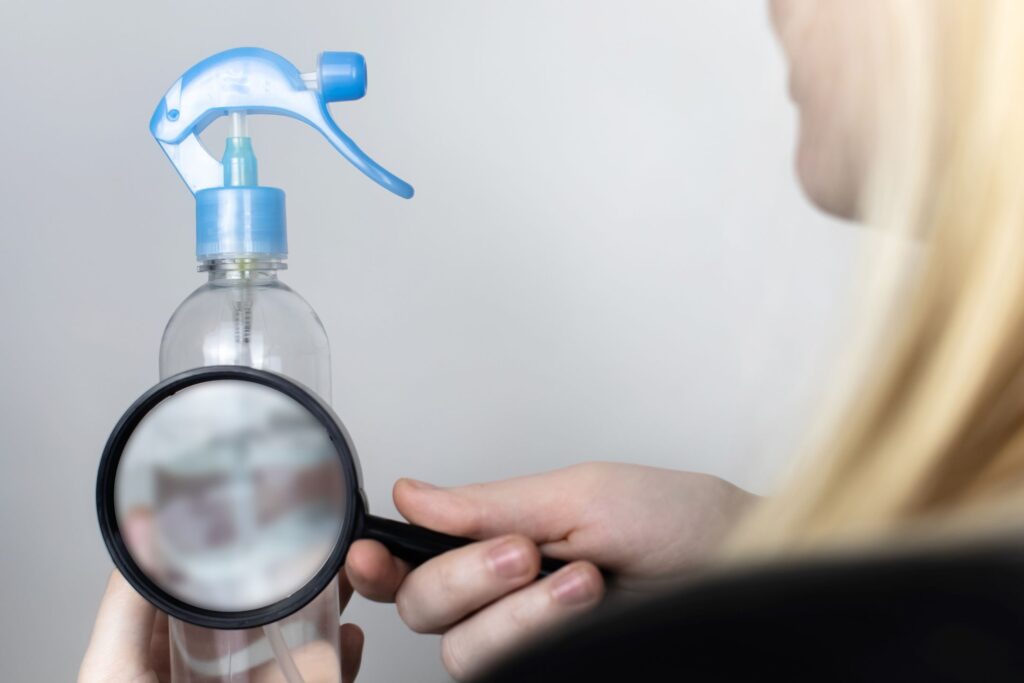
Phthalates, those sneaky chemicals that make plastics flexible and soft, are lurking in a bunch of everyday products. You’ll find them hanging out in vinyl flooring, adhesives, household cleaning supplies, and even in personal care items like soaps and shampoos.
But they’re not so great for our health or the environment.
According to the folks at the National Library of Medicine, certain types of phthalates can mess with the reproductive system of animals, and humans aren’t immune either. Exposure to phthalates has been linked to hormone disruption, lower sperm count, and reproductive issues.
But it gets worse – these phthalates aren’t even bound to the plastics they’re in, so they can escape into the environment over time. That means we could end up with contaminated water and soil. Yikes!
So, what’s the solution? Well, whenever possible, let’s ditch those phthalates and look for safer alternatives. It’s time to show these sneaky little chemicals the door and make choices that are better for us and our planet!
4. Quaternary Ammonium Compounds (QUATS)
What are Quaternary Ammonium Compounds, or QUATS, for short? (Besides a mouthful! 😆)
You’ve probably come across them in conventional household cleaning products like disinfectant sprays, wipes, fabric softeners, even shampoos and conditioners. They’re known for their antimicrobial properties, meaning they can kill all sorts of bacteria, fungi, and viruses.
Sounds great, right? Well….not so much.
Turns out, QUATS can actually be pretty risky for human health. Research published in the National Library of Medicine has linked QUATS to respiratory disorders like asthma, as well as skin problems ranging from rashes to severe burns. 😬
Plus, they can mess with our hormones and reproductive health, just like those pesky phthalates. Not cool, QUATS.
But it doesn’t stop there. A critical review in ACS Publications warns us that QUATS are not eco-friendly and can contaminate the environment. That means using products with QUATS can contribute to the buildup of harmful substances in our ecosystem.
Not exactly what we want for our planet, right?
5. 2-Butoxyethanol
2-Butoxyethanol, another tongue twister, is used in all sorts of products, from paints and cleaning supplies to inks and cosmetics. Now, this compound might be great at cutting grease and removing stains, but it comes with some serious health risks.
Exposure to 2-Butoxyethanol can cause irritation in your eyes, skin, and respiratory tract. And that’s not all – prolonged or high-level exposure can lead to blood disorders, as well as liver and kidney damage.
So, what can we do? Well, it’s simple – steer clear of products that contain 2-Butoxyethanol! Whether it’s glass cleaners, kitchen cleaners, or household cleaning sprays, be sure to read the labels and opt for safer alternatives.
6. Sodium Hydroxide
Sodium Hydroxide, also known as lye or caustic soda, is a pretty common chemical used in different industries. You’ll find it in things like soap making, water treatment, and even paper manufacturing.
It’s pretty handy for keeping things clean, like in drain and oven cleaners.
But Sodium Hydroxide can be risky business. It’s corrosive and can cause some serious burns and eye damage if you’re not careful.
And if you happen to breathe it in, it can lead to some respiratory issues. According to the CDC, Sodium Hydroxide can cause lung damage and kill cells within your tissue if you breathe it in.
Yikes! So, it’s super important to handle products with Sodium Hydroxide with care and look for safer alternatives whenever you can.
7. Perchloroethylene (PERC)

Perchloroethylene, often abbreviated as PERC, is a colorless, non-flammable liquid. Known for its sweet, ether-like odor, PERC is predominantly used in the dry cleaning industry.
Besides its most common label, Perchloroethylene, this chemical goes by several other names. You might also hear it referred to as Tetrachloroethylene, PCE, or Perclorethylene.
In certain industries and regions, it’s also known as PERK, Perc, or Dry-Cleaning Fluid. But no matter what you call it, the health risks associated with PERC exposure remain the same.
It’s favored for its effectiveness in removing dirt, stains, and grease. But despite its efficiency, PERC poses significant health risks.
The CDC suggests that long-term exposure to PERC can adversely affect the central nervous system, liver, and kidneys. Inhalation and direct skin contact can lead to irritation of the upper respiratory tract and the skin.
According to the American Cancer Society, PERC is classified as a Group 2A carcinogen, which means it’s likely to cause cancer in humans.
Considering these potential health risks, it’s advisable to handle products containing PERC carefully and to seek safer alternatives where possible.
Found in spot removers, carpet cleaners, and upholstery cleaners, PERC is a neurotoxin and potential carcinogen.
8. Triclosan
Triclosan is an antibacterial and antifungal agent often found in personal care products and common household cleaners such as multi-surface cleaners, wipes, and detergents. Due to its ability to kill bacteria and other microorganisms, it has been widely used for over four decades.
However, recent studies indicate that triclosan may pose significant health and environmental risks.
According to a report from the Food and Drug Administration (FDA), triclosan is not necessarily more effective than plain soap and water in preventing illness and the spread of certain illnesses.
And some research even suggests that long-term exposure to triclosan can contribute to making bacteria resistant to antibiotics. This phenomenon, known as antibiotic resistance, is a significant public health concern.
Research from the Environmental Working Group (EWG) suggests that triclosan can disrupt the body’s hormone systems, specifically thyroid, testosterone, and estrogen regulation, which could potentially cause a host of health issues.
The National Institutes of Health (NIH) affirms this concern, stating that studies on animals have shown that triclosan alters hormone regulation.
In terms of environmental impact, triclosan is very stable, which means it can accumulate and persist in the environment. It’s often detected in water sources and can harm aquatic wildlife.
In light of these potential risks, it’s recommended to check product labels and opt for triclosan-free products whenever possible.
9. Parabens
Parabens are a type of preservative often found in a variety of personal care products, such as soaps, shampoos, and cosmetics, including household cleaners. They are used to prevent the growth of harmful bacteria and mold, thereby prolonging the shelf life of these products.
However, extensive research has highlighted potential health and environmental hazards associated with parabens.
According to a report from the Breast Cancer Prevention Partners, parabens can mimic estrogen in the body, potentially increasing the risk of breast cancer. And the Environmental Working Group warns that parabens may interfere with the body’s hormones, affecting reproductive health.
From an ecological perspective, parabens are also concerning. A study in Science Direct has found that parabens can accumulate in aquatic environments and may have a toxic effect on marine life.
Because of these potential risks, it’s a good idea to take a look at product labels and opt for paraben-free choices whenever you can. Rather safe than sorry, right?
Toxins in household cleaners FAQs
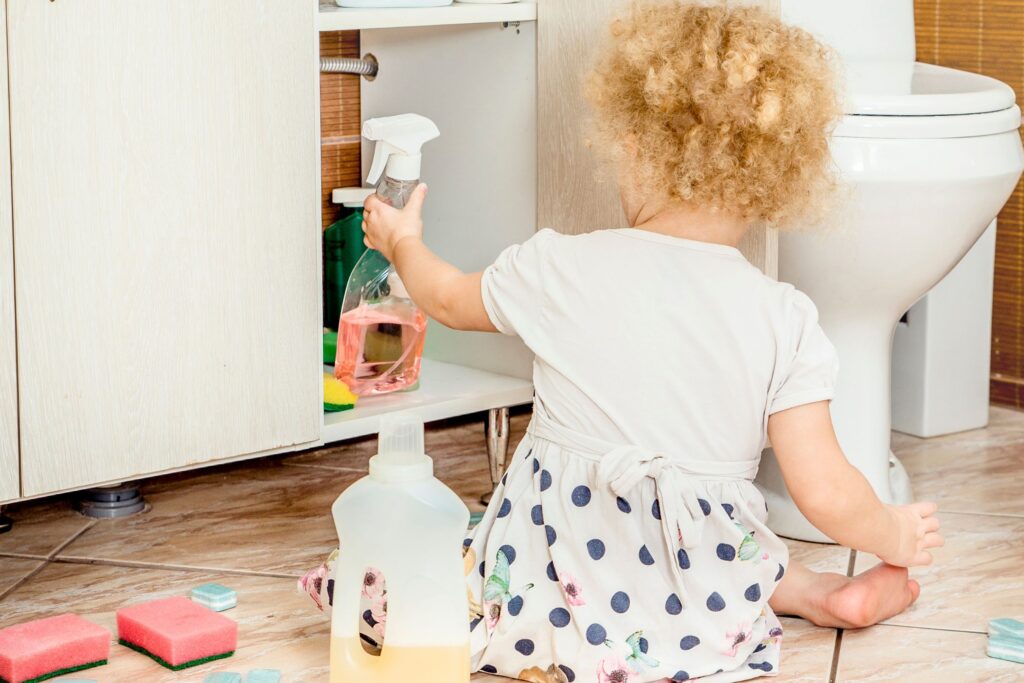
That was certainly a lot to take in! And you might find yourself with more questions now than when you started reading!
Questions like how toxic are household cleaning products, and what kind of household products contain harmful chemicals. It’s completely normal to feel overwhelmed when faced with such significant information, especially when it pertains to your health and the environment.
But it’s okay. We’re here to help you make sense of it all!
In the following section, we’ll try to address some of the most common questions you might have about toxins in household cleaners.
What is the most toxic household cleaner?
The most toxic household cleaner is often considered to be oven cleaners. These products usually contain highly corrosive substances such as sodium hydroxide (lye) or potassium hydroxide, which can cause chemical burns on contact with skin, eyes, or if ingested.
The fumes from oven cleaners can be harmful if inhaled, potentially leading to respiratory symptoms or distress. Always use such products with the utmost caution, wearing protective gear and ensuring good ventilation.
What are the health hazards of cleaning products?
Cleaning products, particularly those that are chemically based, pose a range of potential health hazards. Frequent or prolonged exposure to these household chemicals can cause skin and eye irritation, allergic reactions, and chemical burns.
Airborne exposures generated from cleaning products can lead to respiratory issues, including asthma and other chronic conditions. Some cleaning agents also contain carcinogenic compounds, which, over time, can increase the risk of developing certain types of cancer.
Always ensure to use these products in well-ventilated areas and consider alternatives such as natural or eco-friendly cleaning solutions.
What cleaning products have neurotoxins?
Many cleaning products, particularly air fresheners and products containing fragrance, such as dryer sheets and fabric softeners, have the potential to contain neurotoxins. These are substances that negatively affect the nervous system, potentially leading to a range of symptoms from headaches to more serious neurological disorders.
Carefully read product labels and seek out safer, non-toxic alternatives when possible.
Are household cleaners carcinogenic?
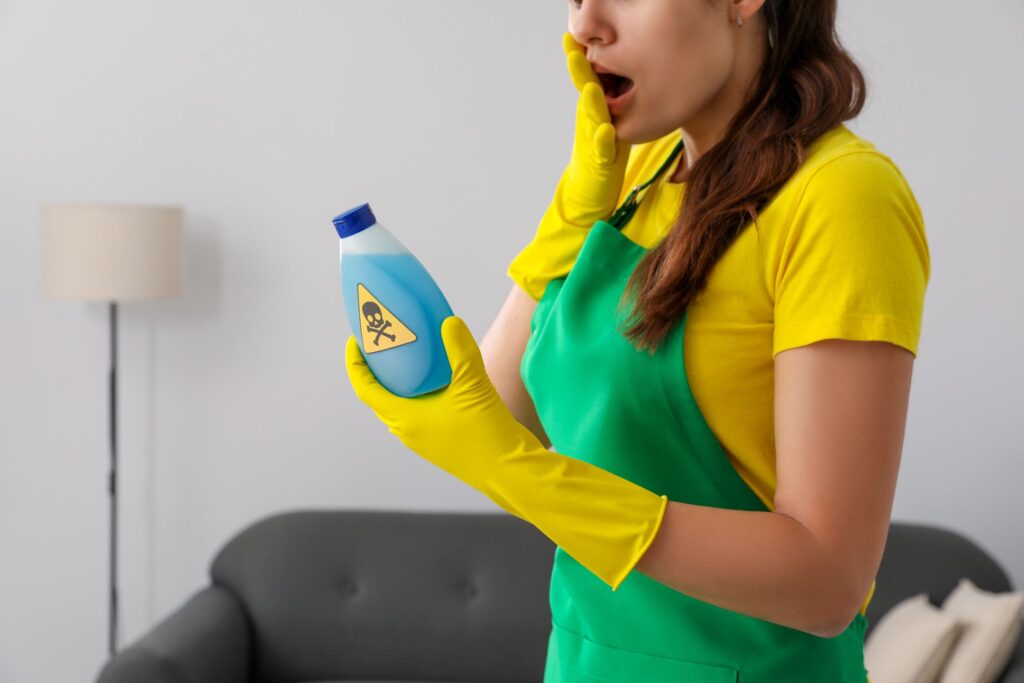
Yes, certain household cleaners can contain carcinogenic substances. Prolonged or frequent exposure to these substances can increase the risk of developing certain types of cancer.
This is particularly true for cleaners that emit volatile organic compounds (VOCs), which have been linked to lung cancer and leukemia. Always exercise caution when using such products, ensuring adequate ventilation and considering safer, eco-friendly alternatives whenever possible.
Can inhaling cleaning products harm you?
Yes, inhaling cleaning products can indeed be harmful. Many cleaning products release volatile organic compounds (VOCs) and other toxic fumes, which can cause respiratory irritation or distress when inhaled.
This can lead to conditions such as an increased asthma risk and other respiratory problems. Chronic or prolonged exposure can even lead to more severe adverse health effects.
Always ensure adequate ventilation when using these products and consider using less toxic or natural alternatives.
How can cleaning products affect your liver?
Cleaning products can potentially affect your liver because many contain harmful chemicals that, when absorbed into the body (through the skin or respiratory system), have to be processed by the liver. Over time, these substances may lead to liver damage or disease due to the organ’s constant exposure to toxins.
To reduce this risk, it’s suggested to use natural or organic cleaning products when possible, and always use protective gear, like gloves, to limit direct contact.
What common household products are toxic?
If you want to know what cleaning products are toxic, you’d better sit down!
Several common household products can be toxic!!
These include: bleach, ammonia, drain cleaners, oven cleaners, dryer sheets, glass cleaner, laundry detergent, antibacterial cleaners, dishwashing detergents, floor cleaners, mildew removers, and so many other household cleaning products, all of which can be hazardous if ingested or inhaled.
Non-stick cookware can also release toxic fumes when overheated. Additionally, many types of paints, varnishes, and air fresheners contain volatile organic compounds (VOCs) that can cause respiratory distress or irritation.
Always use these products with caution and in well-ventilated areas.
What cleaning products are the safest?
The safest cleaning products are those that contain non-toxic, biodegradable ingredients. These include baking soda, vinegar, lemon juice, and essential oils, which are all effective for various cleaning tasks and are harmless to health and the environment.
Brands like Seventh Generation, Ecover, and Healthy Planet Products produce eco-friendly, non-toxic cleaning products. It’s also important to check labels for toxic chemicals before purchasing.
Always opt for fragrance-free products to avoid exposure to phthalates and other harmful substances.
What makes a cleaning product non-toxic?

A cleaning product is considered non-toxic when it is made up of ingredients that are safe for both humans and the environment. These ingredients are typically biodegradable and free from harmful substances such as phthalates, parabens, triclosan, and VOCs.
Non-toxic cleaning products should not cause harmful effects if accidentally ingested, inhaled, or come into contact with skin. They are also designed to break down safely and harmlessly in the environment, thus reducing pollution and promoting sustainability.
Are natural cleaners safe?
Yes, natural cleaners are generally considered safe for both people and the environment. They are made from naturally occurring, non-toxic substances like vinegar, baking soda, and essential oils.
However, it’s essential to remember that not all natural substances are safe (e.g., poison ivy is natural but not safe. 😆). Therefore, always check the ingredients and use them appropriately.
How do you make household cleaners safe?
You can create your own cleaning solutions using non-toxic ingredients commonly found in your pantry. For example, a mixture of vinegar and water can be used for cleaning windows and mirrors, while baking soda and water can form a paste suitable for scrubbing surfaces.
Always store homemade cleaners safely and clearly labeled to avoid confusion. It is also crucial to keep them out of children’s reach.
Opting for certified green cleaning products from reputable brands is another safe choice. Always follow the usage instructions on the product label to ensure safety.
And if in doubt, you can always check out sites like The Environmental Working Group or the Environmental Protection Agency.
After the dust settles…

…after the dust settles, it’s clear that the choice of cleaning products we use in our homes has far-reaching implications. Not only for our health and safety, but also for the planet.
From ditching harmful chemicals to making our own DIY cleaners, we can all play a part in reducing pollution and promoting sustainability. Remember, it might seem like a small change, but when the dust settles, it’s these conscientious steps that can make a world of difference in keeping our homes clean, safe, and eco-friendly.
It’s time to dust off old habits and embrace a cleaner, greener way of living!
Before you go!
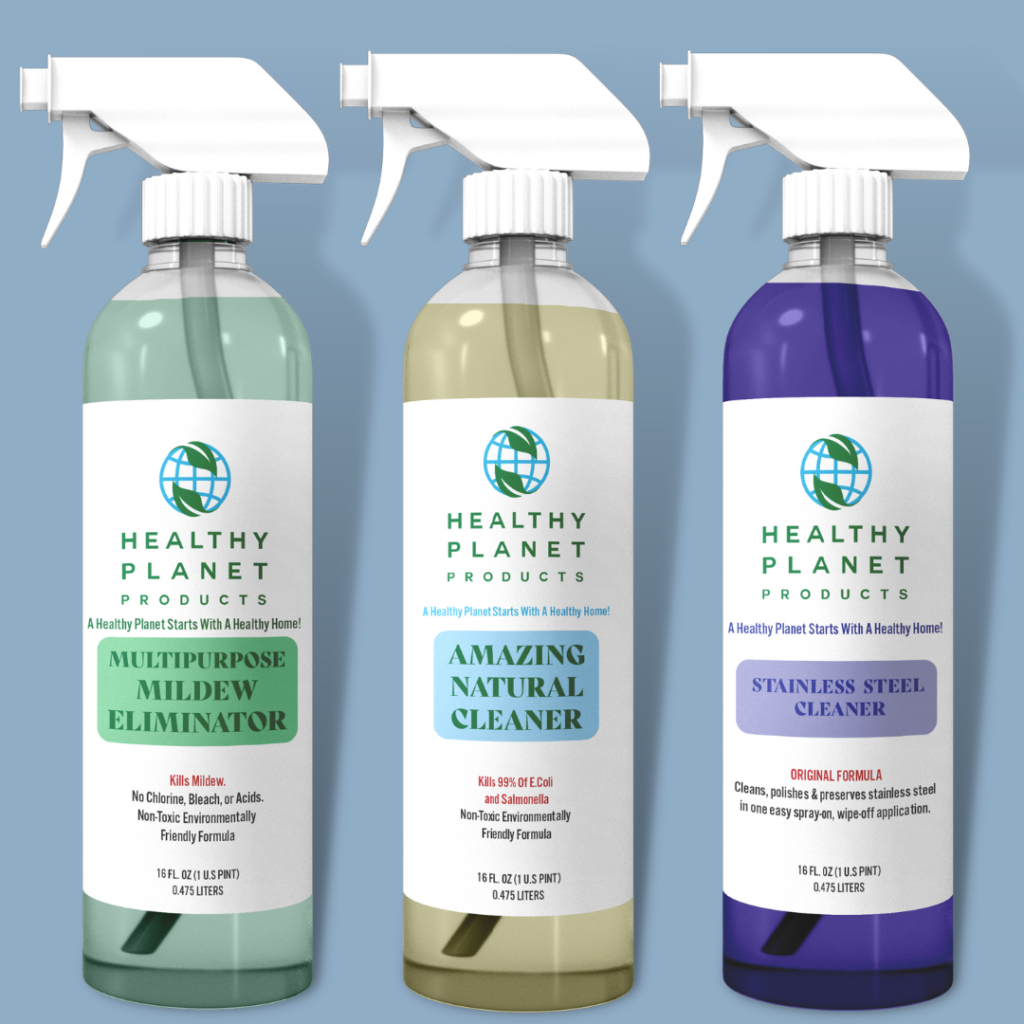
Before you step out, consider taking a stride towards a healthier planet! You can make a difference starting right here at home, by choosing natural, non-toxic cleaning products over the conventional ones.
At Healthy Planet Products, you’ll find a broad range of eco-friendly cleaning solutions that are safe for you, your family, and our planet! Browse our selection today and switch to a cleaner, greener lifestyle that contributes to a more sustainable world.
Your planet will thank you!
Related to harmful ingredients in household cleaning products
Are You Looking for an Easy DIY Nontoxic Dishwasher Detergent Recipe?
The 7 Safest Household Cleaners for a Super Clean Home
4 Best Stainless Steel Cleaner Natural Solutions for a Sparkling Kitchen
The 6 Best Pet Friendly Hardwood Floor Cleaners for Your Family
Here’s the 5 Absolute Best Eco-Friendly Toilet Bowl Cleaners for Your Home
